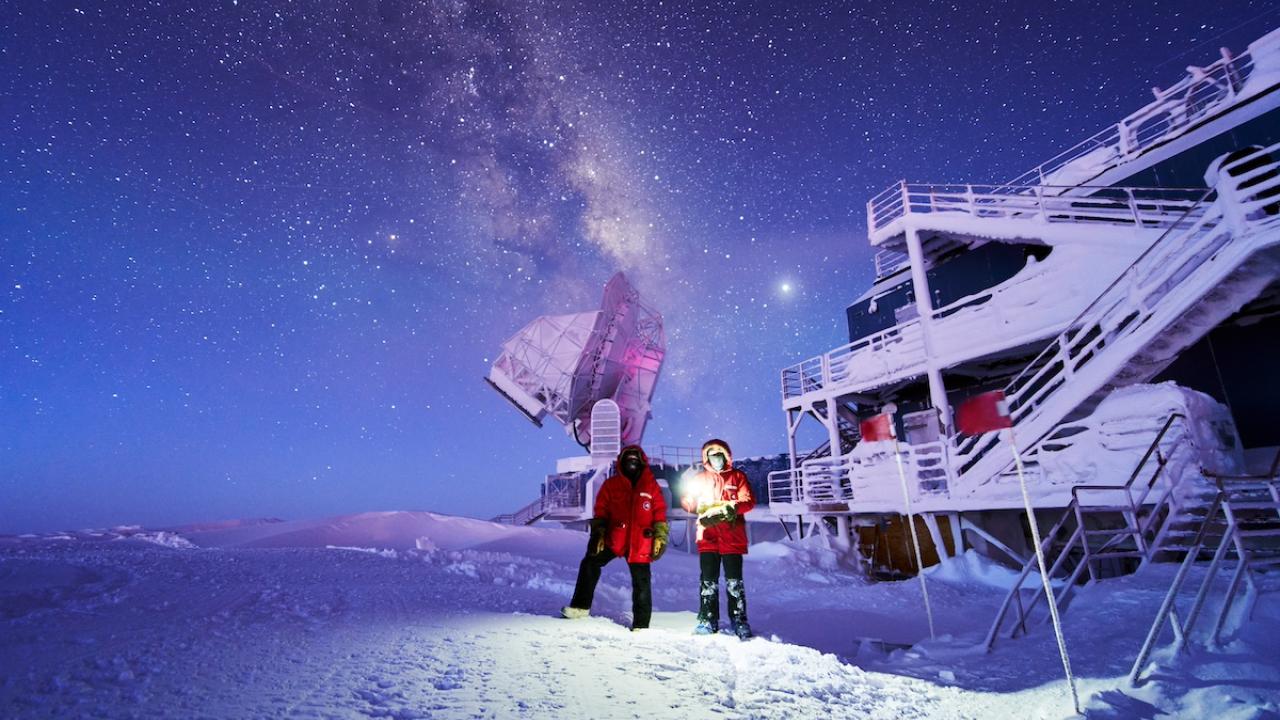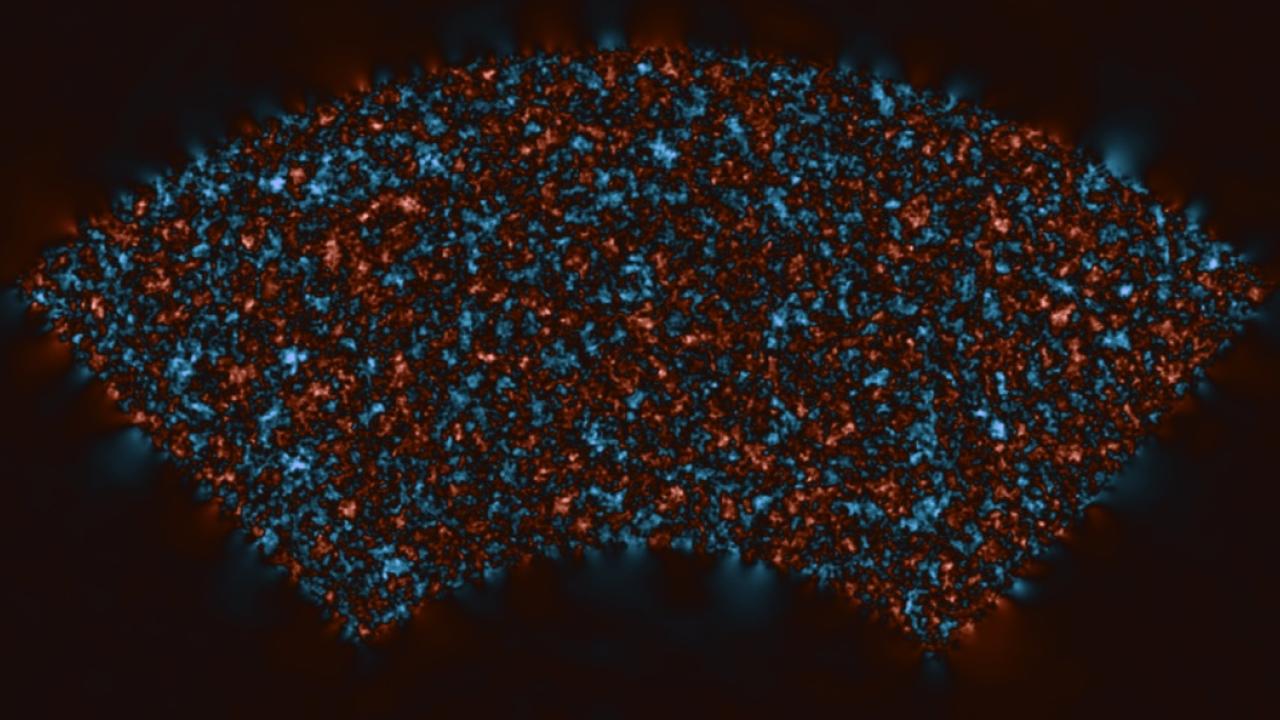
Roughly 400,000 years after the Big Bang, the universe cooled just enough to allow photons to escape from the primordial cosmological soup, an opaque cloud consisting of a plasma of electrons and nuclei. As stars and galaxies formed over the next 14 billion years, these ancient photons — the universe’s first light — continued traveling. This relic light is known as the Cosmic Microwave Background (CMB).
In a preprint study, UC Davis researchers and their colleagues in the South Pole Telescope (SPT) collaboration used observational data of this first light — collected from the SPT located at the National Science Foundation’s Amundsen-Scott South Pole Station in Antarctica — to explore the theoretical underpinnings of the Lambda-cold dark matter model, the standard cosmological model of the Big Bang. The model describes the history of the universe, including its expansion and the growth of large-scale structures over the past 14 billion years.
“We have a largely coherent, detailed, and successful model describing these 14 billion years of evolution,” said Lloyd Knox, the Michael and Ester Vaida Endowed Chair in Cosmology and Astrophysics and one of the study’s co-authors. “But we don’t know what actually generated the initial departures from complete homogeneity that eventually led to all the structures in the universe including ourselves.”
The study, based on high-precision measurements of the CMB and its polarized light, adds further support to the veracity of the standard cosmological model.
“Our results are kind of crossing a threshold where what we are learning from the polarization maps of the CMB is comparable to what we are learning from the CMB intensity maps,” Knox said. “What we are concluding from polarization is also consistent with what we are concluding from intensity.”
The research sheds new light on an outstanding puzzle known as “the Hubble tension,” which concerns discrepancies in the value of the Hubble constant — the rate of the universe’s expansion. The team used their polarization data, combined with the standard cosmological model, to make a new prediction for the rate of expansion. Their prediction is consistent with the prediction made using the CMB intensity maps measured by the Planck satellite, a European Space Agency mission to study the CMB.
A polarizing and winding journey across the universe
In the study, the researchers analyzed two years of polarized light data collected by the SPT in 2019 and 2020. The study’s observations cover 1,500 square degrees of sky and the collected data enabled the researchers to create a large-scale map of the mass in the universe.
Most natural light is unpolarized, composed of a random collection of light waves, each oscillating (waving up and down) with no preferred direction. But when light is reflected it can become polarized, the light oscillating in a preferred direction. This happens when sunlight reflects off water, or the ground, and is the reason polarized sunglasses can be so helpful for reducing glare. It also happened as the CMB photons underwent their final scattering events in the primordial plasma as it began to disappear 14 billion years ago.
“The light from the CMB is partially polarized,” Knox said. “We’re measuring at each location in our sky map the degree to which it’s polarized and the orientation of the polarization."
After that last scattering, the slightly polarized CMB light streamed across open space. Gravitational forces distort the paths of these light rays. Light from different regions is also distorted differently, resulting in a warped image — an effect called gravitational lensing.
To discover both what the polarized image would look like in the absence of gravitational lensing and also the map of the mass causing the gravitational lensing, the team used computers at the National Energy Research Scientific Computing Center (NERSC) in Berkeley.
“What we essentially do at a really high level is we have this data and we send it over to this supercomputer at NERSC,” said Marius Millea, a project scientist with Knox’s research group and the study’s second author. “And the computers are testing this idea, ‘If this were how the real universe looked, would it produce a map that looks like what we saw?’”
“We have the data, but we also need to have a model that produces or predicts these kind of observables,” added Fei Ge, a graduate student with Knox’s research group and study’s first author.

The Hubble tension
The team’s research directly addresses a conundrum in the cosmological community known as “the Hubble tension.” In essence, scientists can’t come to an agreement on the rate of the expansion of the universe, which varies depending on the methodology used to measure it.
In one method, astronomers use the standard cosmological model, combined with observations of the CMB, to predict how rapidly the universe is expanding today.
In another method, they use observations of stars, and stellar explosions called supernovae, to measure the expansion rate more directly. Measurement from this method come in higher — a faster rate of expansion — than the standard model predictions. This is “the Hubble tension,” one of the major puzzles in contemporary cosmology. The origin of the discrepancy is unknown.
The team’s new prediction is precise enough to be discrepant with the more direct measurements at very high statistical significance. It aligns more with the rate of expansion predicted by the standard cosmological model and CMB intensity method.
The study emphasizes the Hubble tension, with the polarization representing one more hoop that any solution will have to jump through.
Funding acknowledgment: The South Pole Telescope Collaboration receives funding from the National Science Foundation’s Office of Polar Programs and the U.S. Department of Energy’s Office of Science High Energy Physics. The work at UC Davis was also supported by a gift from Michael and Ester Vaida.
YOU MAY ALSO LIKE THESE STORIES

A Galaxy of Memories with Lori Lubin
Light pollution dampens our view of the stars, hindering our connection to the universe above. It’s one of the reasons why astronomical observatories are erected in remote, often pristine, places. The opportunity to travel to such places drew Lori Lubin to astronomy.

Illuminating Pathways
Held every spring quarter, the the Department of Physics and Astronomy's Alumni Seminar Program features Aggie alums from the department discussing ways they’ve applied their degree post-graduation.
